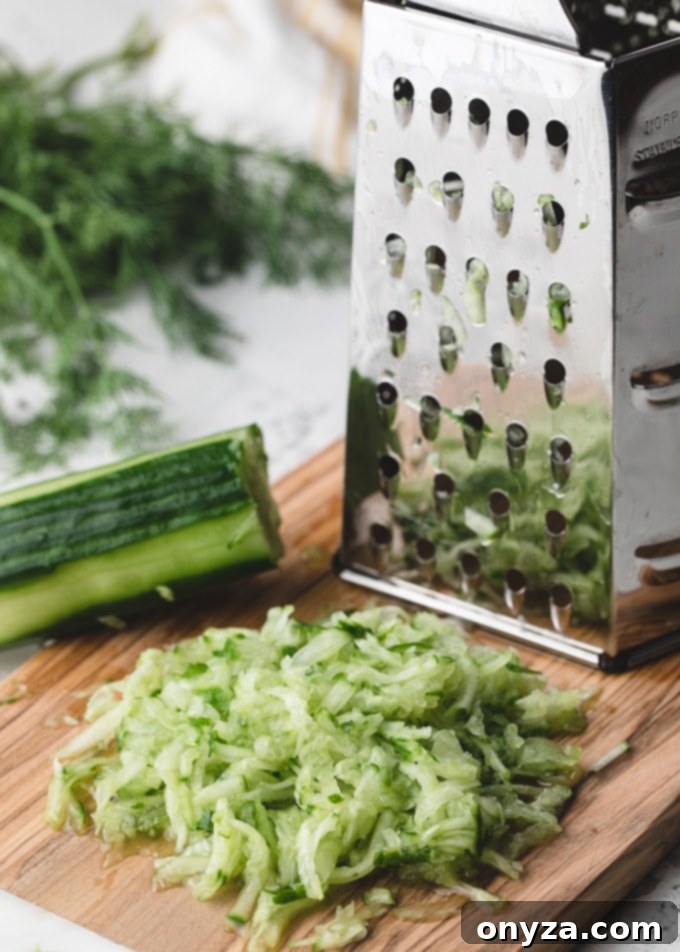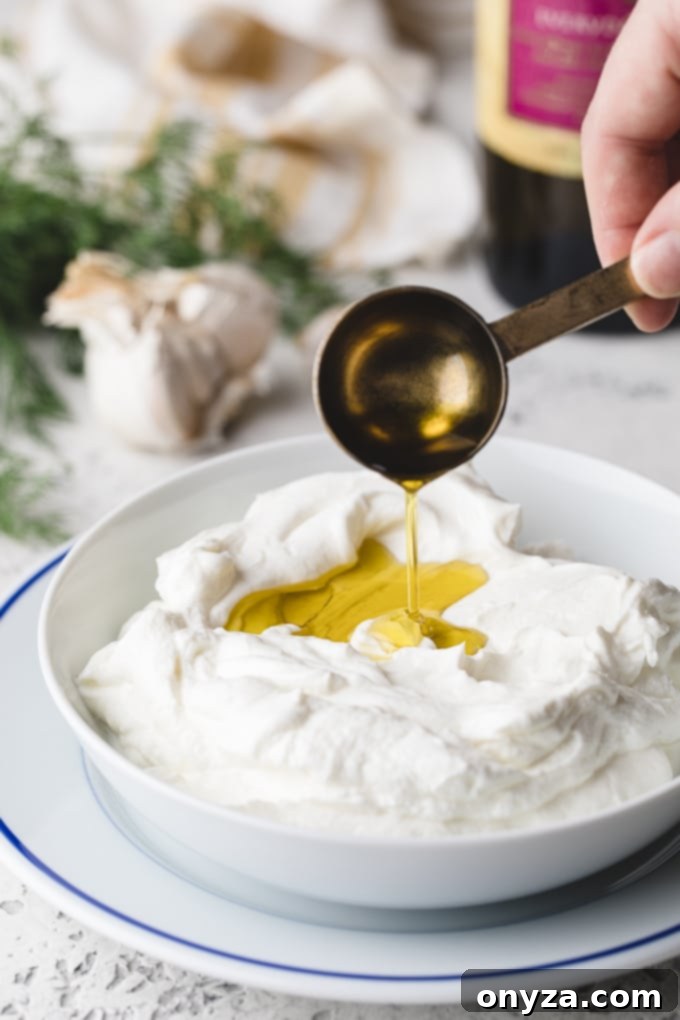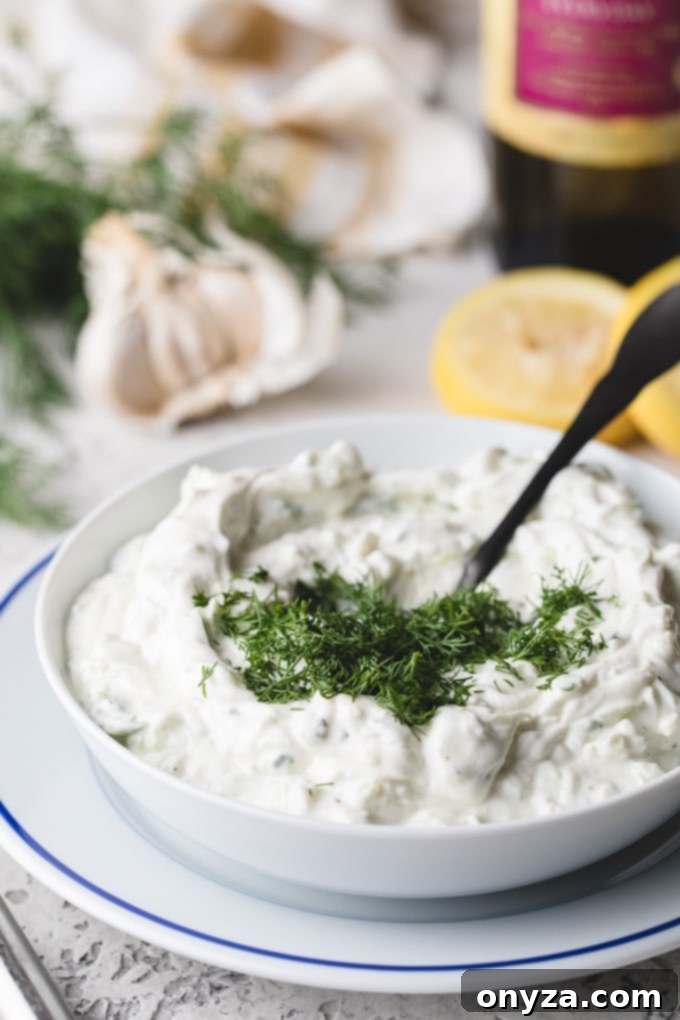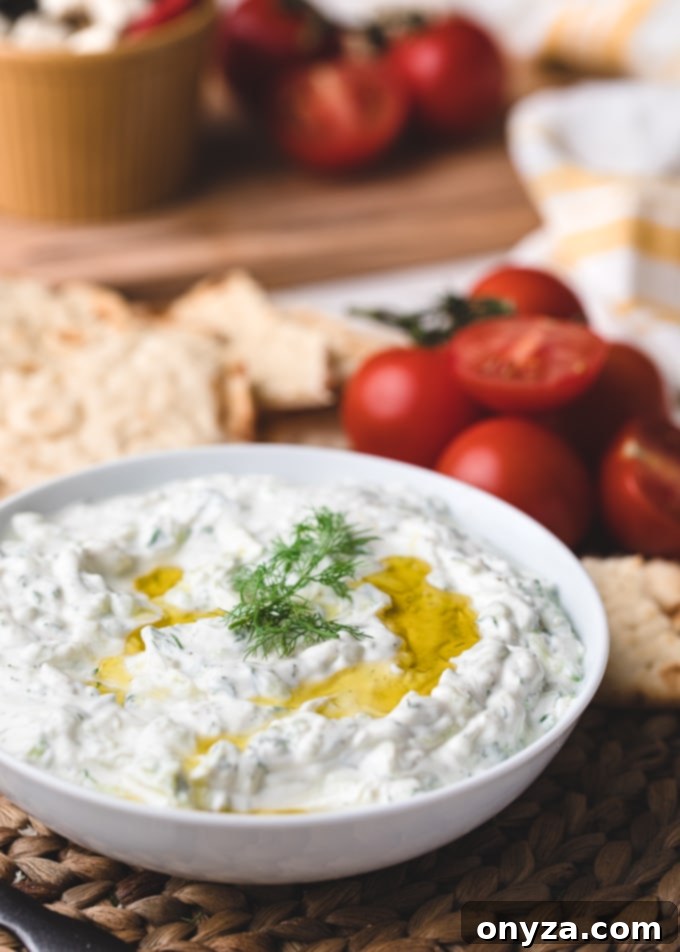Welcome to the definitive guide for crafting the most delectable homemade Tzatziki! This timeless Greek delight, with its creamy texture, refreshing cucumber crunch, and aromatic garlic kick, is much more than just a dip. It’s a versatile condiment that elevates everything from sizzling grilled meats and seafood to your favorite sandwiches and vibrant mezze platters. Forget store-bought versions; discover the simple secret to authentic, flavorful Tzatziki that will become a staple in your kitchen.
For connoisseurs of fresh, vibrant flavors, Tzatziki often sits at the pinnacle of condiments that one could happily enjoy straight from the bowl. Its harmonious blend of creamy, tangy, and subtly spicy notes creates a truly invigorating experience. For years, I, like many, relied on commercially prepared Tzatziki after first tasting its authentic glory in a charming Greek restaurant. However, the search for that perfect “Goldilocks” brand proved elusive. Store-bought options often fell short, either being overly tart, lacking in garlic, or, more often than not, laden with preservatives that compromised their fresh appeal.
The quest for that genuine, restaurant-quality taste led me to explore making Tzatziki at home. With invaluable insights from a friend of Greek heritage, I embarked on a journey to perfect a homemade recipe. The beauty of crafting it yourself lies in the complete control you gain over proportions and textures, allowing for a truly personalized and superior product. This particular recipe has since become an indispensable part of my culinary repertoire, gracing our refrigerator year-round, but finding particular popularity during the warmer spring and summer months when its cooling properties are most appreciated.

What is Tzatziki Sauce? An Authentic Greek Delight
Tzatziki (pronounced saht-ZEE-key in American English) is a beloved Mediterranean, specifically Greek, yogurt-based sauce renowned for its refreshing qualities. At its heart, it’s a simple yet incredibly flavorful blend of strained yogurt, finely grated cucumber, fresh garlic, a hint of olive oil, and often fresh herbs like dill or mint. This iconic condiment is a cornerstone of Greek cuisine, offering a cool contrast to rich grilled meats and a delightful tang to appetizers.
While the Greek version is the most globally recognized, variations of this cooling yogurt sauce can be found across various Mediterranean and Middle Eastern cultures. For instance, in Turkey, a similar dish is known as cacik, which is notably thinner and sometimes served as a cold soup. The term “tzatziki” itself is believed to derive from the Turkish word. Bulgaria offers tarator, another cousin to tzatziki, which shares many ingredients but incorporates walnuts and is thinned with water or ice to create a chilled soup-like consistency. These regional differences highlight the shared culinary heritage while emphasizing the unique character of each country’s interpretation.
Even within Greece, you might encounter subtle regional nuances in Tzatziki recipes. These variations typically concern the choice of herbs – some regions favor dill for its fresh, slightly anise-like flavor, while others prefer mint for a brighter, more pungent note. The preparation of the cucumber can also vary, with some traditionalists opting for finely diced pieces instead of grated, though grating is widely preferred for achieving a smoother, creamier sauce that is ideal for dipping and spreading.

The Creamy Base: Choosing the Best Yogurt for Homemade Tzatziki
The foundation of an outstanding Greek Tzatziki is undeniably strained yogurt. This isn’t just any yogurt; it’s yogurt that has had much of its whey removed, resulting in a significantly thicker, richer, and tangier product. For optimal authenticity and ease, purchasing plain Greek yogurt is highly recommended, as it has already undergone the straining process. Many culinary enthusiasts consider brands like Fage to offer an excellent balance of flavor, richness, and ideal texture for Tzatziki.
Greek yogurt is now readily available in most major grocery stores, making it convenient for home cooks. However, if you find yourself without access to it, or if you prefer a truly hands-on approach, you can easily strain regular plain yogurt at home. This typically involves placing plain yogurt in a cheesecloth-lined sieve over a bowl and allowing it to drain in the refrigerator for several hours or overnight. This simple step will transform thinner yogurt into a rich, strained consistency perfect for your Tzatziki.
When selecting your Greek yogurt, I personally lean towards whole milk Greek yogurt for my homemade Tzatziki. Its inherent richness provides a luxurious mouthfeel and a perfectly balanced tartness that complements the other ingredients without being overwhelming. The fat content contributes significantly to the sauce’s body and helps to mellow the sharp flavors of garlic and vinegar.
While whole milk yogurt is preferred for its superior texture and flavor, you absolutely can use low-fat or non-fat Greek yogurt in this recipe. Be mindful, however, that reduced-fat varieties tend to be more tart than their full-fat counterparts. If you opt for a lower-fat yogurt, it’s wise to be conservative with the addition of white vinegar or lemon juice initially. Add a smaller amount than specified, then taste and adjust as needed, gradually increasing the acidity until it reaches your desired balance. This careful approach ensures your Tzatziki achieves the perfect flavor profile, regardless of your yogurt choice.

Mastering Cucumber Prep for Perfectly Creamy Tzatziki
The cucumber component is just as crucial as the yogurt for achieving that signature creamy, yet refreshing Tzatziki texture. For my homemade recipe, I consistently choose grated cucumbers over diced. Grating yields finer shreds that integrate seamlessly into the yogurt, creating a smooth and cohesive sauce that is ideal for dolloping, dipping, and spreading. While a food processor with a shredder disk can be a time-saver for large quantities, I’ve found that the large holes of a standard box grater provide the best results, creating perfect shreds and facilitating the crucial liquid extraction.
The ultimate secret to a thick, luscious Tzatziki that won’t become watery after sitting is effectively drawing out the excess moisture from the cucumbers before mixing them into the yogurt. This essential step is akin to preparing certain vegetable-based salads, like my Homemade Coleslaw recipe, where moisture control prevents a soggy end product. After grating your cucumbers, place them in a strainer nested over a bowl. Sprinkle them generously with a little kosher salt and allow them to rest for approximately 30 minutes. During this time, osmosis will work its magic, drawing out a surprising amount of liquid.
Once the resting period is complete, firmly press the grated cucumbers with the back of a spoon or a rubber spatula to extract even more moisture. You’ll be astonished by the volume of water collected in the bowl – discarding this liquid is key! For an extra measure of dryness, gently transfer the pressed cucumbers onto a double layer of paper towels and press again, ensuring all residual moisture is absorbed. While this step adds a small amount of time to the preparation, it is **absolutely essential for achieving that desirable thick, creamy Tzatziki texture.** Skipping this step will result in a runny, less flavorful sauce that won’t hold up well.
Choosing the Right Cucumber Variety for Tzatziki
When it comes to selecting cucumbers for Tzatziki, I consistently reach for English cucumbers. These long, slender varieties are perfect for Tzatziki due to their delicate, thin skins and minimal, often imperceptible seeds. I like to peel them in an alternating “stripe” pattern, leaving some green peel intact. This not only adds a touch of visual appeal and textural interest to the sauce but also retains some of the peel’s nutritional benefits. Their mild flavor also ensures they don’t overpower the other fresh ingredients.
If you’re using other cucumber varieties with thicker skins, such as standard garden cucumbers or those with a waxy coating, it’s best to peel them entirely before grating. Thicker cucumber skins can sometimes impart a slightly bitter taste, which would detract from the refreshing quality of your Tzatziki. Additionally, if your chosen cucumber variety has large, prominent seeds, I recommend slicing the cucumber in half lengthwise and using a small spoon to scoop out and discard the seedy core before grating. This prevents an unappealing watery or seedy texture in your final sauce, ensuring a consistently smooth and pleasant bite.
For those interested in exploring the diverse world of cucumbers, A Brief Guide To Types of Cucumbers from The Spruce Eats offers a fantastic overview to help you identify the best options for all your culinary needs, including your next batch of homemade Tzatziki.

Versatile Uses for Homemade Tzatziki Sauce
Homemade Tzatziki is an incredibly versatile condiment, offering a burst of bright, garlicky, and utterly refreshing flavor to an array of dishes. Its applications extend far beyond a simple dip, making it a true kitchen hero. Here are some of our favorite ways to enjoy this Greek classic:
- As a Dip: This is its most classic role. Serve Tzatziki with warm, fluffy pita bread, crisp vegetable sticks (cherry tomatoes, cucumber slices, bell pepper strips, carrots), or even crackers. It’s also an indispensable component of any authentic mezze platter, accompanying olives, feta cheese, dolmades, and other Mediterranean small bites.
- With Grilled Meats and Seafood: The cooling, tangy profile of Tzatziki makes it an ideal accompaniment for rich, char-grilled flavors. It’s a traditional pairing for gyros and souvlaki, but don’t limit yourself! It’s fantastic with lamb chops, grilled chicken, juicy salmon fillets, or even lighter fare like poached shrimp.
- On Sandwiches and Wraps: Elevate your lunch! Spoon Tzatziki into pita-style sandwiches, chicken or falafel wraps, or even serve it as a vibrant spread on turkey or veggie burgers. Its creamy texture adds moisture and a wonderful depth of flavor.
- Burgers with a Mediterranean Twist: For a delightful change from traditional condiments, slather homemade Tzatziki on your burgers. It pairs exceptionally well with chicken, turkey, and seafood burgers, offering a light and zesty alternative to mayonnaise or ketchup.
- Alongside Roasted Vegetables: Drizzle Tzatziki over warm roasted potatoes, zucchini, eggplant, or bell peppers for an instant flavor upgrade. It brightens and adds a creamy element to hearty vegetable dishes.
- In Salads: Thicken your potato salad with Tzatziki for a lighter, tangier version, or thin it slightly with a touch more olive oil to create a vibrant dressing for green salads.
- Savory Breakfast/Brunch: For an adventurous palate, serve a dollop of Tzatziki with savory egg dishes, especially those with Mediterranean influences, or as part of a savory yogurt bowl with herbs and spices.
The beauty of homemade Tzatziki is its reasonable shelf life. Stored properly in an airtight container in the refrigerator, it maintains its freshness and vibrant flavor for up to 3 days. This means you can enjoy its versatility across several meals throughout the week – or, as mentioned, simply savor it by the spoonful!
More Refreshing Dips and Dressings to Explore
If you love the versatility and fresh flavors of homemade Tzatziki, you’ll surely enjoy exploring other delicious sauces and dressings that can transform your meals. Expand your culinary repertoire with these excellent homemade options:
- Homemade Russian Dressing
- Creamy Cilantro Lime Sauce
- Homemade Tartar Sauce
- Creamy Horseradish Sauce
- Buttermilk Blue Cheese Dressing
- Homemade Cocktail Sauce
Homemade Tzatziki Recipe
Yields: 18 servings (2 tablespoons each)
Prep Time: 30 minutes
Cook Time: 10 minutes (for flavor development)
Resting Time: 1 hour minimum
Total Time: 1 hour 40 minutes
This thick and creamy homemade Tzatziki is easy to make and serves as a refreshing condiment for pitas, grilled meats and seafoods, or as a delightful dip.
Ingredients
- 1 cup grated cucumber (about 1 whole English cucumber, fully peeled or peeled in stripes)
- 2 cups whole Greek yogurt (see notes for alternatives)
- 2 tablespoons extra virgin olive oil
- 1 tablespoon white vinegar or fresh lemon juice (see notes)
- 2 cloves garlic, minced
- 2 tablespoons fresh dill or mint (dill is most commonly used)
- Kosher salt and freshly ground black pepper, to taste
Instructions
- Place the grated cucumber in a strainer set over a bowl. Toss with 1/4 teaspoon of kosher salt. Allow it to stand for 30 minutes. Discard the liquid that collects in the bowl. Press the cucumbers firmly between double layers of paper towels to remove any excess water. This step is crucial for a thick, creamy Tzatziki.
- In a medium bowl, whisk together the Greek yogurt, extra virgin olive oil, white vinegar or lemon juice, and minced garlic. Season with 1/2 teaspoon each of kosher salt and black pepper.
- Stir the well-drained cucumbers and fresh dill or mint into the yogurt mixture until thoroughly combined.
- Cover the bowl and refrigerate for at least 1 hour to allow the flavors to meld and develop. For best results, chill for several hours or overnight.
- Before serving, give the Tzatziki a good stir and taste. Adjust seasoning with additional salt, pepper, or vinegar/lemon juice, if desired, to achieve your preferred balance of flavors.
- Store homemade Tzatziki in an airtight container in the refrigerator for up to 3 days.
Notes
- White wine vinegar is often considered authentic to Tzatziki in Greece, offering a distinct sharpness. Substituting fresh lemon juice provides a slightly milder and brighter tartness. Choose according to your preference.
- While whole milk Greek yogurt is recommended for the richest texture and flavor, you can use reduced-fat or fat-free Greek yogurt. Be aware that these varieties can be more tart. If substituting, start with less vinegar or lemon juice and add gradually to taste, as needed.
- For more ideas on how to serve your delicious homemade Tzatziki, refer to the “Versatile Uses” section above in the blog post.
Nutrition Estimate (per 2 tablespoon serving)
- Calories: 28 kcal
- Carbohydrates: 1g
- Protein: 2g
- Fat: 1g
- Cholesterol: 1mg
- Sodium: 8mg
- Potassium: 41mg
- Vitamin A: 10 IU
- Vitamin C: 0.7mg
- Calcium: 26mg
Nutrition information is automatically calculated and should be used as an approximation. Actual values may vary based on specific ingredients and preparation methods.
About Our Recipes
Please note that our recipes are developed using the US Customary measurement system and have not been tested for high altitude/elevation cooking and baking conditions.
There’s nothing quite like the satisfaction of creating a vibrant, flavorful dish from scratch, and homemade Tzatziki is a prime example. From the creamy Greek yogurt to the crisp cucumber and pungent garlic, each ingredient plays a vital role in crafting this refreshing sauce. We encourage you to try this recipe and experience the difference that fresh, homemade ingredients make. We’re confident it will become a cherished recipe in your kitchen, enjoyed by family and friends alike!
